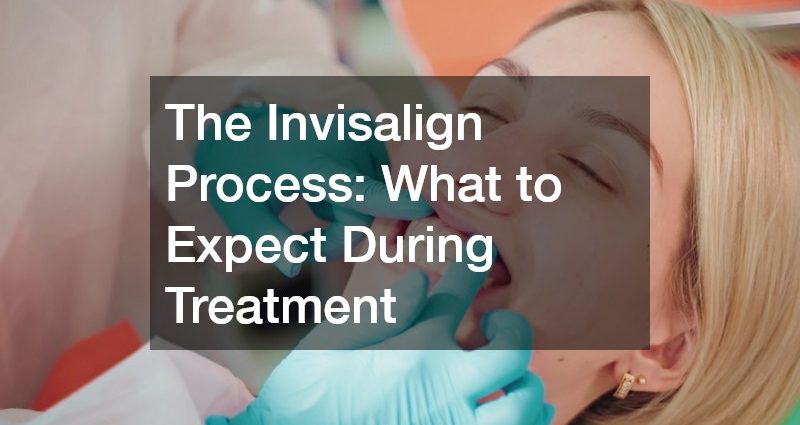
Invisalign has become an increasingly popular choice for individuals seeking a discreet and effective way to straighten their teeth. Unlike traditional braces, Invisalign uses clear, removable aligners to gradually shift teeth into their ideal position. Understanding the Invisalign process—from consultation to post-treatment maintenance—can help patients feel confident and prepared throughout their orthodontic journey.
What is Invisalign and How Does it Work?
Understanding Invisalign Technology
The treatment relies on advanced 3D digital imaging to map a patient’s teeth and design a personalized treatment plan. This technology allows orthodontists to predict tooth movement and create a sequence of aligners tailored to each patient’s needs.
The Benefits of Using Invisalign
Invisalign offers multiple advantages, including nearly invisible aligners, reduced discomfort compared to metal braces, and the ability to remove aligners for eating, brushing, and flossing.
Difference Between Invisalign and Traditional Braces
Unlike traditional braces, which use brackets and wires to move teeth, Invisalign relies on clear plastic aligners. This makes it more aesthetically pleasing and allows for easier oral hygiene. Additionally, treatment with Invisalign often requires fewer in-office adjustments.
Types of Dental Issues Invisalign Can Address
Invisalign can treat a variety of dental concerns, including crowded or overlapping teeth, gaps between teeth, overbites, underbites, and mild to moderate misalignments.
The Science Behind Invisalign Aligners
Each aligner is made from medical-grade, BPA-free thermoplastic and is designed to move teeth slightly until they reach the desired alignment. Aligners are typically worn for one to two weeks before switching to the next set in the series.
How Long Does Invisalign Treatment Take?
Initial Consultation and Customized Treatment Plan
Treatment begins with a consultation where the orthodontist evaluates oral health, takes digital scans or impressions, and develops a personalized plan.
Typical Duration of Treatment for Various Cases
Treatment time varies depending on the complexity of the case. Mild misalignments may take as little as 6 months, while more complex cases can require 12–18 months of consistent aligner use.
Factors that Influence Treatment Time
Patient compliance, age, and the severity of misalignment are key factors. Wearing aligners 20–22 hours per day is crucial for staying on schedule.
The Role of Regular Dental Check-Ups
Periodic visits to the orthodontist ensure proper progression, allow for adjustments, and address any concerns during treatment.
Post-Treatment Retainers and Maintenance
After completing Invisalign treatment, wearing retainers is essential to maintain results and prevent teeth from shifting back to their original positions.
What is the Cost of Invisalign Treatment?
Average Cost Compared to Traditional Braces
Invisalign is generally comparable in cost to traditional braces, although fees vary based on complexity and location.
Insurance Coverage and Invisalign
Many dental insurance plans cover a portion of Invisalign treatment, often similar to coverage for braces. Patients should confirm with their provider before beginning treatment.
Payment Plans and Financing Options
Many dental offices offer financing or installment plans to help manage the cost of treatment.
Factors Influencing the Cost of Treatment
Treatment duration, number of aligners required, and the need for additional procedures, such as attachments or interproximal reduction, can affect the total cost.
Tips for Managing Invisalign Expenses
Consider flexible spending accounts, insurance benefits, and payment plans. Early consultation can help patients plan financially and avoid surprises.
What to Expect During the Invisalign Treatment
Initial Fitting and Placement of Aligners
The orthodontist ensures the first set of aligners fits properly and provides instructions on insertion, removal, and wear schedules.
Day-to-Day Wear and Lifestyle Adjustments
Aligners should be worn consistently, removed only for eating, drinking, brushing, and flossing. Patients may need to adjust to speaking or minor pressure initially.
Caring for Your Aligners: Cleaning and Maintenance
Proper hygiene involves brushing the aligners daily, rinsing them regularly, and avoiding exposure to heat that could warp the plastic.
Common Challenges and How to Overcome Them
Mild discomfort or tightness is common when switching aligners. Over-the-counter pain relief and following proper insertion techniques can help ease discomfort.
Monitoring Progress and Adapting Treatment
Routine check-ups allow the orthodontist to track progress and make modifications as needed to ensure optimal results.
Are There Any Side Effects or Risks With Invisalign?
Potential Discomfort and How to Alleviate It
Temporary soreness or pressure is normal and typically subsides after a few days.
Possible Risks and How to Minimize Them
Poor compliance or damaged aligners can slow progress or affect results. Following instructions closely and attending appointments minimizes risk.
Ensuring Proper Alignment and Fit
Orthodontic visits are crucial for evaluating fit and making adjustments. Proper fit ensures teeth move as planned.
The Importance of Following Treatment Guidelines
Consistent wear and adherence to instructions are essential for achieving desired outcomes.
When to Contact Your Orthodontist
Persistent discomfort, broken aligners, or unexpected changes in tooth positioning should prompt a call to your orthodontist.
The Invisalign process offers a modern, discreet, and effective alternative to traditional braces. From the initial consultation to wearing aligners, attending check-ups, and maintaining results with retainers, understanding each step helps patients achieve a healthy, beautifully aligned smile. By following professional guidance and maintaining good oral habits, Invisalign can provide long-lasting dental benefits while fitting seamlessly into daily life.


